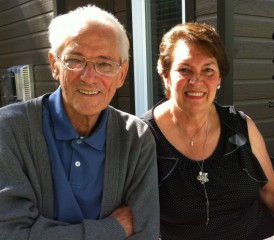Budwig Protocol Led to Dramatic Comeback for Mesothelioma Survivor

When they left the hospital in June, Marilyn B. was told that her husband, James, belonged in a hospice facility, where they could make him as comfortable as possible through his final weeks with malignant pleural mesothelioma.
Fortunately, she didn’t listen, taking a detour to their home instead, arriving with her own shot-in-the-dark plan, unwilling to accept the medical advice that previously led to the chemotherapy regimen that almost killed him.
Thank goodness, she didn’t listen this time.
She just started feeding him.
The couple, whose last name is being withheld over privacy concerns, turned to the Budwig Protocol, a radical change of diet that revolves around a special oil-protein mixture that includes cold-pressed flaxseed oil and cottage cheese. It provides the essential omega-3 acids that become the sparks for cells to detoxify, fill with oxygen, and function optimally.
It has worked miraculously for James.
“When we left the hospital, all they talked about was palliative care, that he needed to be where they can take care of you when you’re dying,” Marilyn said from their home in Ottawa, Ontario. “I said no, no, no. There has to be something else out there. We just weren’t ready to give up. I don’t know exactly why this works, or how long it will work, but it’s remarkable how well he is right now. He went out and shoveled some snow off the drive the other day.”
James, 74, came home in a wheelchair, with an oxygen tank to help his breathing, a PleurX catheter to regularly drain fluid from his lungs, and with kidneys that were hardly functioning. You wouldn’t know that today.
Over the following few months, the wheelchair became a walker, then a cane, then disappeared entirely. The catheter is long gone because the lungs are working at 95 percent capacity with no trace of fluid. He has regained more than the 20 pounds he lost. His complexion is back to normal. And the nurse who used to come every few days to check on him, has no reason to come anymore.
“You can’t ever get rid of the mesothelioma, but you can get rid of, or shrink, the tumors,” Marilyn said. “I do know something very good has happened since he went on this diet. Most doctors really don’t know enough about nutrition, supplements and the natural process, I don’t think. Most people I know still go the conventional medicine route. And at the beginning, we went there, but it just didn’t work. People should understand that other things can work.”
First Diagnosed in 2011
James was diagnosed with pleural mesothelioma in July 2011, but it was too far advanced to make surgery an option. The usual chemotherapy combination of cisplatin and Alimta didn’t do much except leave him with frustrating side effects as the disease progressed.
Early in 2012, he was switched to the chemotherapy drug Gemcitabine, which sent him on a downward spiral that included dramatic weight loss and multiple blood transfusions as his white blood cells and platelet counts dropped to dangerous levels. His breathing worsened, and his lungs were filling up with fluid.
“They pretty much told me, there was nothing more they could do,” Marilyn recalled. “They didn’t think he had much longer to live. So we had nothing to lose, by trying this diet. Every night I’d leave the hospital, I’d go home and search the Internet for answers. This one made sense. That’s why I wanted to bring him home.”
Learn about your diagnosis, top doctors and how to pay for treatment.
Get Your Free GuideBudwig Protocol
She found the Budwig Protocol, an anti-cancer diet that was first conceived in 1953 by Johanna Budwig, a German biochemist. Budwig, who died in 2003, claimed that if followed properly, it could dramatically shrink tumors and sometimes eliminate them completely.
In addition to the flaxseed oil/cottage cheese mixture, the diet consists of meals high in fruits, vegetables and fibers. It avoids all processed foods, most meats, sugar, hydrogenated oils and butter and margarine.
Twice daily now, Marilyn blends and James consumes his 16-ounce drink, which includes the flaxseed oil/cottage cheese mixture, along with any number of fruits, berries and vegetables blended together.
Breakfast is usually a bowl of cooked porridge or oats with fruit and almond milk. Lunch is a sandwich with whole grain bread, plenty of vegetables and a small amount of chicken or fish. Dinner is more vegetables and another small portion of chicken, turkey or fish, and fruit.
He also takes extra vitamins and a supplement called Daily Orac Power, which includes more than 30 different fruits and vegetables. Among those are cabbage greens, elderberry, celery, brussels sprouts, carrots, beets, barley grass, alfalfa, soy fiber and a Japanese seaweed blend.
“Something is working,” Marilyn said. “His tumors now are either gone, or they are lying dormant and not building up fluid anymore. He’s walking up steps, taking short walks, doing a bunch of things he just couldn’t do before. Our daughter looks at him in disbelief, how much better he seems.”
This wasn’t the first time the Bloomers had traveled this road through cancer. Their daughter was diagnosed with breast cancer four years before, enduring several surgeries and chemotherapy treatment sessions. She still is being monitored closely.
“I’ve been through this with my daughter, and I learned from that,” Marilyn said. “Oncologists don’t understand this (mesothelioma) disease enough. When they decide they can’t do anything for you anymore, that’s when you feel lost. And we were there. We were fortunate to find something that worked for us. Otherwise, I don’t know what would have happened.”